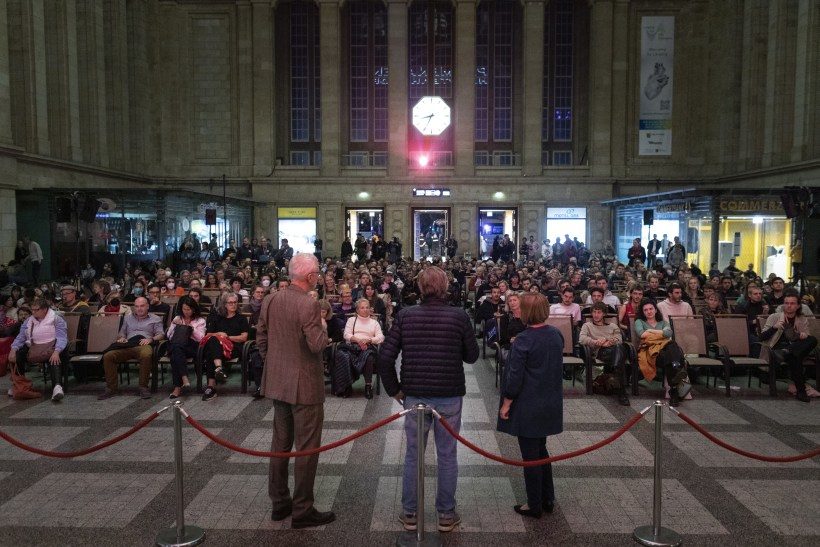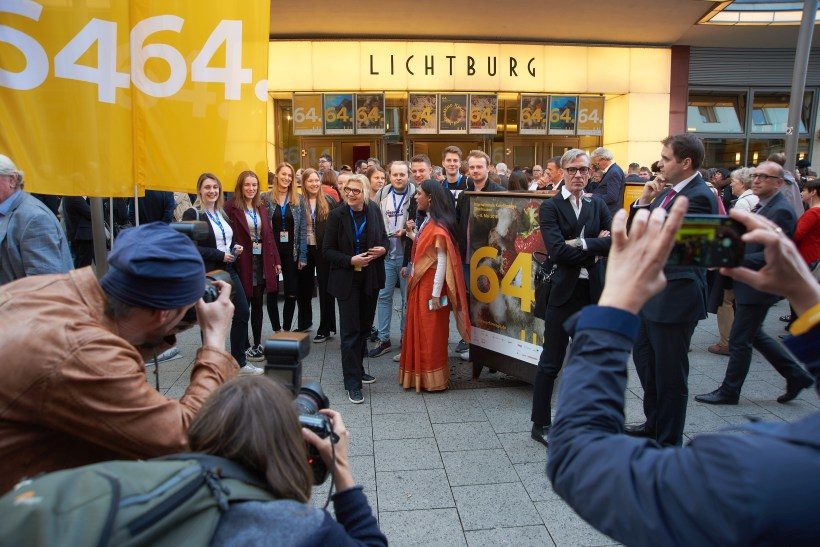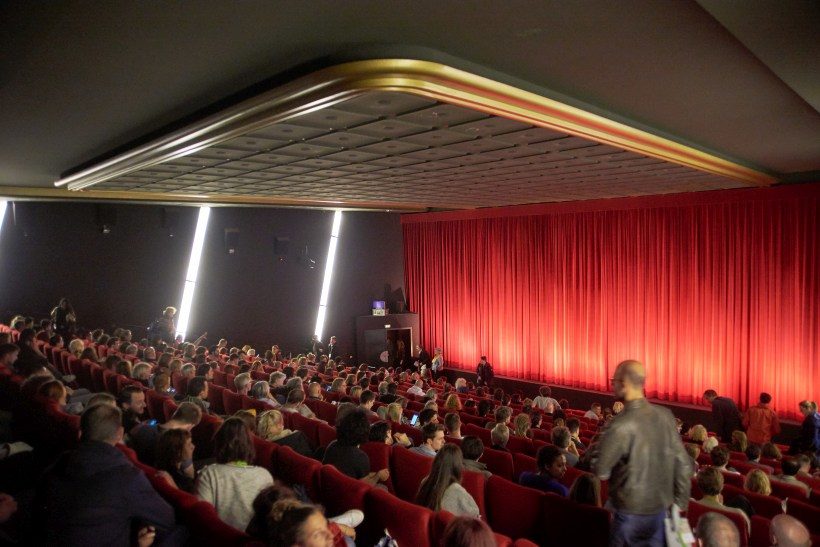In their highly readable anthology “Film Festivals – Crises, Opportunities, Perspectives,” the authors Tanja C. Krainhöfer and Joachim Kurz explore the situation in the German film festival scene, and that especially during and after the corona pandemic.

Opening Night DOK Leipzig 2022 © Viktoria Conzelmann
The corona virus together with its related measures also forced the German film festivals to question their own actions and activities, as well as to fathom completely new routes to their audiences. However, unlike numerous theaters and museums that remained secure, relatively speaking, during this exceptional situation thanks to institutional funding and support, the vast majority of the more than 400 German film festivals was facing the problem that, in one go, they were threatened with the loss of the cinema box-office takings as well as some of their project funding, not to mention the money from sponsors. Especially for smaller festivals, the closure of the cinemas even put their very existence at risk.
The Corona Pandemic as Show Stopper, Nemesis and Springboard
Despite this elementary “to be or not to be” crisis situation, numerous organizers behind the festival curtains, so-to-speak, also availed of this forced shutdown as an opportunity to scrutinize formats and approaches, as well as to seek out new routes for permitting films to reach their audiences, as indeed for the audiences to reach out to each other.
Between such existential fears and new mental spaces, an extraordinary amount of new ideas, routes and methods arose, which were tested out by the festivals without dwelling long on the considerations involved. Everywhere, “out of the box” thinking prevailed together with a “jumping into cold water” mentality. In the individual texts from that time, one would read that the exacerbated situation was regarded as threatening and liberating at one and the same time.
Yet for that, the situations of the festivals compiled in this book were and are each quite different. One of them has existed for more than 50 years, while another one was hit by the pandemic in its launch year. Short film festivals follow a different logic to feature-length film festivals. There is also quite a difference as to whether a festival screens fictional, documentary or animated films, and whether the films and guests are regional or international. Festivals with competition sections work differently to festivals with thematic programs, and festivals with (pandemic-compatible, comparatively speaking) time slots in the summer were blessed with different baseline conditions compared to those festivals that were held between October and March, or, in other words, exactly during the critical time of year for respiratory infections.
Balancing Act with the Internet and Double Basis – Digital, Analog or even Hybrid?
Despite all the difficulties, from today’s perspective, surprisingly few events were completely cancelled. Several festivals rescued themselves by shifting their time slots. Others that had sufficient time to prepare thanks to their having later screening dates took the risk of relocating their programs into virtual space. And other ones decided, when faced with a lack of planning certainty, to even implement a hybrid concept. Which meant that they organized a program for screening in cinemas, while also conducting events in digital space at the same time. All of those who risked this balancing act with the internet and a double basis, so-to-speak, for one or even two times, are of the same opinion today: Anyone planning a hybrid festival is actually planning two festivals and must face the additional costs caused by this. Something which, in the first corona year, was only do-able for many “the first time around” through courage born of desperation and adrenaline, soon revealed itself to be a blatantly excessive demand on the organizers. Because their financial scope had decreased rather than increased, and establishing parallel digital structures required clearly more resources (both human and financial) than initially thought.
The question behind this of whether the installing of their own streaming solutions is beneficial or detrimental to the festivals and the individual films has been discussed in a highly controversial manner – right up to today. While some worry that they are cutting off their own cinema audiences with the online screenings, others praise the low-threshold aspect of the digital screenings and the new opportunities for (digital) participation.
Steep Learning Curve, Practical Solidarity and Unexpected Resilience
There was just one aspect that almost all of the voices in the anthology under review were able to agree upon: This challenging time was followed by a phase consisting of a steep learning curve and intensive exchanges.
“The pandemic was the best training measure we have ever had.”
Lars Henrik Gass, p. 292
The new empirical data generated were – despite all the competing for films, audiences and funding – shared among everyone. Some festivals, such as the goEast festival, which had to be cancelled because of the pandemic, were “adopted” by other festivals (in this case, the exground filmfest) and permitted to screen a part of their program in their partner festival’s cinemas during the festival run. The German AG Filmfestival lobbying body was founded in July 2019, and over 120 festivals (of the more than 400 large and small festivals in Germany) have organized themselves in it, in order to represent their interests mutually. Unlike initially thought, corona did not in fact lead to major cutbacks in the film festival scene. The German film festivals proved to be more resilient than expected and have certainly gained some positive insights and knowledge from the pandemic time.
Krainhöfer and Kurz ultimately identify four factors that, from their perspective, contributed to the German film festivals surviving the pandemic period relatively well:
“A crisis-tested and resilient (if also frequently precarious) organizational structure; a style of action borne by flexibility, courage and perseverance; a remarkable learning curve resulting from regular and comprehensive exchanges of experience and knowledge from day one of the pandemic; an irrevocable commitment to film culture and to their responsibility for the filmmakers.”
Tanja C. Krainhöfer, Joachim Kurz, p. 62
Reversing the Downturn – Film Festivals as Future Labs of Film Culture
In fact, the trend already being observed prior to the pandemic was confirmed: Although the cinema audience numbers have been decreasing continuously for years (also without corona) and it seems that the demise of the cinemas is unstoppable, the festival sector enjoyed consistent growth until the corona pandemic. According to the book editors, among others, this seems to be due to the fact that festivals are more than film screening venues. Thanks to their compact, localized structure, they have become events achieving success where normal cinemas do so less and less: In bringing people together. The numerous accompanying program elements that are typical for festivals, such as film talks, panel debates, workshops, conferences and discussions, provide critical social spaces for discourses and function as initiators and driving forces. Whoever attends an event in the context of a festival experiences more than a film.
“Every festival screens films, but it produces evaluations, narratives, histories, critical discourses, theories. In other words, it produces ‘criteria’ of film culture.”
Georg Seeßlen, p. 18
For the cinemas and film scene, festivals are also important meeting places, in the context of which networks are formed and cooperations forged. And, last but not least: For many films beyond the Hollywood blockbuster cinema hits, by now festivals have become their most important non-digital sales and marketing channel ever, because increasing numbers of good and excellent films no longer take the classic cinema exploitation route at all anymore. Thus, according to the book editors’ argumentation, festivals have become elementary channels of distribution.
Moreover, thanks to their ability to react quickly to new developments, festivals have developed into drivers of innovation for the complete film industry:
“In order to remain agile – and resilient in crisis situations – self-reflection and impartial open-mindedness are decisive. And with this decisive attitude, festivals are then also able to function in the future as labs for developments – as a living organism requiring a design and structure shared and created by the filmmakers and the audiences.”
Sascha Keilholz, p. 173
Finally Taking Festivals Seriously as Central Elements in Film Publicity (and Evaluation)
The growing significance of the festivals for the film culture must, as many demand, finally also be reflected in the state film-funding logics, which to date have regarded festival screenings in the biography of a film all too often as merely the icing on the cake and not an essential basis.
In fact by now, quite a large share of the films that are screened and win awards at festivals do not find regular distributors. The general oversupply of films, the continuous reduction in the number of screens and cinemas showing films, and a film funding policy that accords distribution little attention, relatively speaking, and sticks with outdated exploitation chains account for the causes here. The concentration of the film funding on the “classic” cinema releases represents a stopgap solution that is adhered to although everyone involved knows that the underlying conditions have long changed. But because everyone involved in this long exploitation chain are afraid of taking a step in a different direction, serious suggestions for reform that view the issue from all perspectives have been rare to date.
“I believe that the complete exploitation chain of the so-called arthouse films has to be reconsidered. We all know that the distribution funding in Germany is not on the same level as the number of films awaiting cinema distribution and exploitation. For this reason, the distribution funding should not be further decimated. And this enforced cinema exploitation has to be urgently revised, anyway. It is only when you put us, the film festivals, on the same level as classic cinema exploitation that we can consider specific funding instruments. But unfortunately the policies do not seem to be there yet – which I really regret.”
Albert Wiederspiel, p. 209
Strength Is Found in Differences – But also Challenges
In this situation, it is essential to bear in mind that differing distribution and exploitation opportunities occur for various kinds of films. Unlike the typical arthouse film that Albert Wiederspiel would like to screen at Filmfest Hamburg (and that preferably as a premiere) just before it aims for its cinema release, many documentaries and short films are not intended for classic cinema screenings at all. This is not the only reason why the viewpoints of the organizers of major feature film festivals differ so conspicuously from the positions of short film festivals or festivals with a more political-thematic direction, such as SINEMA TRANSTOPIA from Berlin.
The former wonder how they should position themselves as festivals within the general exploitation process of the film industry and which interactions between the festivals, the cinema scene, the audiences and the film funding occur or could occur. With the question arising over and again of how programming decisions impact on the film scene and on the individual films.

Opening 64th Kurzfilmtage Oberhausen 2018 © Kurzfilmtage / Daniel Gasenzer
Those festivals whose profiles demonstrate significantly fewer direct overlaps with the film industry are also, in terms of their own definition, far less dependent on the capitalist market logic models. They are more likely to question how the film festival they organize as a cultural offering impacts on their audiences and ultimately on the whole of society. From this perspective, a film festival is less a marketplace or place of diversion; instead, it should provide the occasion and space for debates and critical discussions, and even hold a mirror up to society in the best case.
“We are making culture not to entertain, but because we want to reflect something back on the society that is financing us, which it does not want to see.”
Lars Henrik Gass, p. 295
In his inspiring foreword, Georg Seeßlen succeeds not only in elaborating these poles, between which all film festivals ultimately sway, but also in unifying them in a comprehensive and inclusive definition of film festivals, comparatively speaking.
“Film festivals have a responsibility not only in relation to the films and their producers, but also to their own inner mini-sociologies and indeed to the public sphere created by them, which is never a solely cineaste one. There are no ‘apolitical’ film festivals.
Georg Seeßlen p. 10
Self-Awareness(es), But Without a Mirror, Unfortunately
It seems to be entirely deliberate on the part of Seeßlen that many narratives develop in parallel in the contributions to this anthology, and that this occurs; that they mutually reinforce each other in some places and even contradict each other clearly in others.
Despite all the differences, it can be said that anyone organizing film festivals in Germany in 2023 apparently does so with a great sense of commitment and a certain inclination to self-exploitation. In line with the dictum that “screening films is not enough” (Angela Haardt), all of the festivals provide discursive spaces, in which people enter into conversations about what they have seen and experienced. This form of eventization is not concerned with pomp and red carpets, but rather with providing an alternative to our individualized filmic experience that bears the strength of utopia within it. Or – to put it in Georg Seeßlen’s words: It is concerned with no less than to change the world, to which film festivals – to render it emotionally – can and must contribute their share. With his credo, “When a film festival does not have a utopian core, then it is not worth visiting,” the film critic would seem to be expressing what everyone writing in this anthology feels.
The sole shortcoming in this rich anthology consists, in my opinion, of the fact that the information provided by the festivals organizers themselves is not supplemented, reflected and amended as required with the perspectives from other ‘players’ in this field. Would it not be exciting, together with all the enthusiastic ideas for achieving audience loyalty, to also see the perspectives of longstanding festival visitors reflected here? Which strategies do the various funding institutes pursue, be that on regional, national or European levels? How do the public TV broadcasters view film festivals and how do cinema owners regard festivals? And ultimately, what is the relationship of the filmmakers themselves with the festivals, which do like to regard themselves as ‘film midwives’?
Films and Festivals Do NOT Occur in an Empty Space (also not in a Digital One)
That these perspectives are lacking in the anthology under review is due beyond doubt to capacity issues, but it still remains a pity. Yet even in its current version, “Film Festivals – Crises, Opportunities, Perspectives” is a broad and stimulating read, at the end of which the insight arises that the film festivals in Germany can, against all the odds, certainly look to the future with optimism, and that not least because they have succeeded to date – and apparently better than many cinemas – in retaining their audiences and even expanding them. At this point, one last direct reference to the book seems appropriate, as it is repeatedly pointed out that even all the newly created festival digital spaces are in no way capable of replacing the location where the heart of film truly beats: the cinemas.

full movie theatre, Kurzfilmtage Oberhausen 2019 © Kurzfilmtage / Daniel Gasenzer
And in order to preserve the cinemas as the genuine locations of film, it has long been overdue that both the festivals, as well as the film funding and the cultural policies join forces so as to maintain and strengthen cinemas as locations of film art and as spaces for debates. For without a location, there is no event and, regardless of their resilience, the festivals are fundamentally dependent on being able to screen in the cinema spaces. No festival is able to create a cinema infrastructure from scratch for the 5, 7 or 11 days that their festival runs, and thus the preservation of the cinemas currently available has to be a fundamental interest for the festivals, and that for completely egotistical reasons. The array of cinemas that has been lost to date will not return. For this reason, festivals have to make every effort hand in hand with the cinemas (and ultimately also with the other film culture players) to protect and preserve what is still there and, through targeted mediation work, to gain new audience groups for the cinemas as the location for an active and committed film culture.
“Cinema is a cultural technology that needs to be preserved and which should be treated on an equal footing with classic music, or jazz, or theater, or painting.”
Christoph Terhechte, p. 336
Tanja C. Krainhöfer, Joachim Kurz
Filmfestivals – Krisen, Chancen, Perspektiven
Oktober 2022, 387 Seiten, farbige und s/w-Abb.,
ISBN 978-3-96707-725-4
featuered image: DOK Leipzig ShortnSweet 19.10.2022 © Lukas Diller